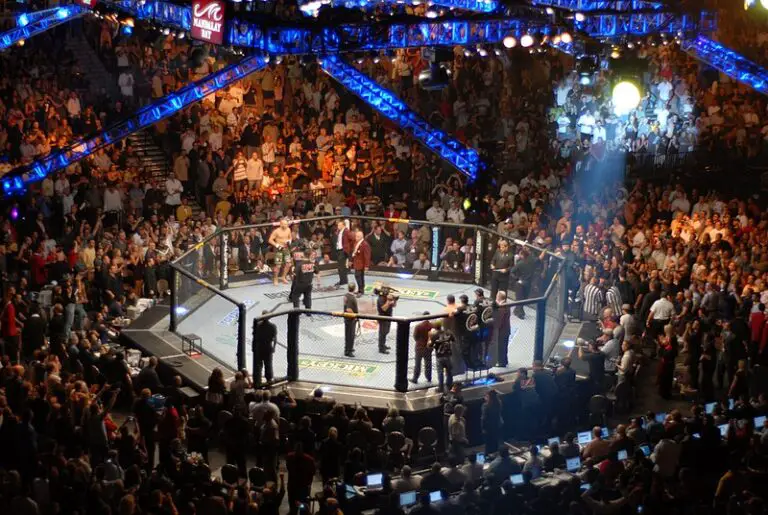The UFC is the absolute leader in the MMA industry in every measurement. According to statistics, the UFC holds 90% of the market share meaning that they earn 90 cents of every dollar generated in the MMA industry and many people wonder how UFC makes so much money.
The UFC’s main source of revenue are pay-per-view sales, ticket sales in live events, and sponsorship and TV deals. Next, they also earn a lot from merchandising, ability to keep the costs of production low, and their online streaming service known as “UFC Fight Pass”.
In this article, we are going to take a closer look at the different methods and strategies UFC uses to make money, and how much profit they enjoy from their events.
1. Pay-Per-View (PPV) Events
The sale of Pay-Per-View broadcasts is at the core of how UFC makes money. This represents the main source of their income and is the reason why the biggest and most popular events are aired on PPV. These events include only the finest fighters on the roster, and the main event is always a high-profile title bout.
ESPN+ is the main broadcaster of PPV events in the US, and the price for watching each one is quite high (around $100 for new users). Despite the high prices, the company manages to stay consistent in terms of sales which secures them massive revenue.
The following five events have generated the most PPV buys in history:
- Khabib vs. Mcgregor (UFC 229) – 2.4 million
- Diaz vs. Mcgregor (UFC 202) – 1.6 million
- Poirier vs. Mcgregor (UFC 257) – 1.6 million
2. Ticket Sales
Live events held in arenas and stadiums are not just about the crowd’s roar — these also generate big money. Ticket sales vary based on location, seating, and the importance of the fight card, adding to the organization’s bottom line. Thus, the prices may vary between the countries where the event takes place.
However, the ones that generate the most revenue are usually held in countries like the US and Australia. These shows take place in big arenas or even stadiums, like UFC 255 in Sydney, Australia. Arenas can host around 20 thousand people, while the Stadiums can have up to 50 thousand in the crowd.
On average, UFC tickets can range from about $50 to $500 or even more for really good seats. So the math is simple – the UFC makes a lot of money from ticket sales. For instance, they cashed out 17.7 million for UFC 205 event, and 17.2 million for UFC 229 from ticket sales alone.
3. Television and Broadcasting Rights
UFC strikes lucrative deals with television networks and streaming services for broadcasting rights. Over the course of history, the company worked with the largest sports networks in the world. This includes Spike TV, FOX, and of course, ESPN.
They work with many cable providers and streaming services outside the US which boosts their revenue. Some of their deals include partnerships with:
- BT Sport (United Kingdom) – BT Sport is a key broadcaster for events in the United Kingdom and Ireland.
- TSN (Canada) – TSN has been a long-standing partner for broadcasting UFC events in Canada.
- Globo (Brazil) – In Brazil, Globo has been involved in broadcasting events, making the fights accessible to the Brazilian audience.
- Network Ten (Australia) – UFC events are broadcasted on Network Ten in Australia, bringing the fights to fans down under.
- DAZN (Global) – DAZN is a global streaming service that has secured rights to broadcast events in various countries.
- OSN Sports (Middle East) – OSN Sports has been a broadcaster for events in the Middle East and North Africa.
The UFC works with cable and satellite providers, which are like the companies that bring TV channels to your home. These providers pay the UFC to show the fights on their channels. Also, there are digital platforms like streaming services (think of apps like Netflix or Hulu) that get the rights to broadcast UFC events online.
This way, people all around the world can watch the fights live or catch up later. These deals with TV and streaming services are a big part of how the UFC makes money. For instance, they get 300 million a year from ESPN alone.
4. Sponsorships and Advertising
The UFC secures sponsorships from various companies. Some of the most their largest sponsors over the years include brands like Reebok, Venum, Bud Light, Modelo, Harley Davidson, and Monster energy drinks.
These companies have been visible in the UFC through fighter sponsorships, event promotions, and other collaborative efforts. Keep in mind that sponsorships can change over time as new deals are made.
These brands pay the UFC to advertise their brand on fighters’ clothing, canvas, or octagon corners. Every visible spot during the broadcast includes some type of advertising.
As an example, their deal with Bud Light is worth over $100 million.
Additionally, advertising revenue flows in through commercial breaks during broadcasts, amplifying the financial success of the organization.
5. Merchandising
UFC’s brand extends beyond the octagon, with fans eager to sport clothing, gear, and accessories featuring the iconic logos. UFC sells all kinds of gear and accessories, both online and at the events where the fights happen. So, whether you’re at home or lucky enough to be at the event, you can buy things like hats, shirts, and even unique items with the UFC’s iconic logos.
During the fight week, fighters also sign thousands of posters, t-shirts, and hats, and the price of these can go high. When fans buy these things, it’s not just about looking cool — it also helps the UFC make money. Merchandise sales, both online and at events, contribute to the UFC’s revenue while allowing fans to connect with the brand on a personal level.
- Basic UFC logo T-shirts can range from $20 to $40, depending on the style and any additional graphics or designs.
- Caps typically cost between $20 and $40, with variations based on style and any added features
- Hoodies or sweatshirts might fall in the range of $40 to $80 or more, depending on factors like material and design complexity.
- UFC-branded shorts, commonly worn for training or casual wear, might be priced between $30 and $60.
6. Fighter Contracts
Fighters play a pivotal role in company’s success, and the organization ensures their involvement by offering lucrative UFC contracts. Although fighter pay remains a point of contention, the UFC saves money by reducing production costs, particularly in this area.
For instance, the salary of UFC fighters hasn’t changed much over the years. This is mainly because the company gives between 15–18% of their revenue for fighter salaries. Though this may sound as much, it isn’t because in other sports like the NFL, close to 50% of revenue goes to fighters.
However, UFC is a monopoly in the MMA industry and this secures them a big negotiating power. It allows them to keep the wages low, much lower than in other leagues, and this way, save/earn a lot of money.
However, this practice has drawn criticism from both within and outside the sport, as it leads to a wide disparity between the earnings of top performers and those at the lower end of the roster.
7. UFC Fight Pass
For fans who love watching UFC anytime, anywhere, there’s something special called UFC Fight Pass. This is a streaming service, kind of like when you watch movies on Netflix. With UFC Fight Pass, subscribers can access a huge library of past fights — the legendary ones, the nail-biters, and all the action you might have missed.
But it’s not just about the old stuff; you also get to watch exclusive content that you won’t find on regular TV. And here’s the cool part — you can even catch live events that aren’t on the usual channels. In most cases, the UFC would air early prelims of Fight Pass before moving to ESPN+.
Apart from the UFC, fight pass also includes the library of matches from other promotions. MMA fans can watch legendary PRIDE events, Cage Warriors, or even K-1 kickboxing. There are also different TV shows, grappling events, and much more.
UFC’s reach extends far beyond its American roots. Hosting events globally, the organization secures international broadcasting deals, establishing a diverse fan base and contributing to the global appeal and financial success of the UFC.
8. UFC Gym Franchise
The UFC earns money from licensing UFC Gyms through a structured franchising model.
Individuals or groups interested in opening a UFC Gym location must pay an initial franchise fee to the UFC. This fee grants them the rights to use the UFC brand, logo, and business model for their gym. The franchise fee can vary depending on factors such as the location, size, and potential market of the gym.
Next, UFC Gyms must adhere to specific brand standards and guidelines set forth by the UFC. This ensures consistency across all UFC Gym locations and helps maintain the integrity of the brand. The UFC provides ongoing support, training, and marketing assistance to franchisees to help them succeed and grow their businesses.
How Much Money the UFC is making
According to recent reports, the UFC generated more revenue in 2022 than every other combat sports promotion combined, raking in a record high of $1.140 billion
The UFC’s net income (profits) grew from $119 million in 2015 to $177 million in 2020 to $272 in 2021 and reached $387 million in 2022, a margin of 34%
The UFC’s impressive increase in revenue can be attributed to its media rights and content, live events, sponsorships, and consumer product licensing deals, all of which set new records for the promotion in 2022
1However, the UFC has been criticized for reducing production costs, particularly in athlete contracts, which has led to a wide disparity between the earnings of top performers and those at the lower end of the roster
The UFC’s revenue share with its fighters hovers around 13–15%, which is considerably less than other major sports leagues.
What Is The UFC’s Market Worth?
Current reports suggest that the promotion is now valued at an astounding $12.3 billion, reflecting a significant return on investment for the Endeavor Group.
In 2001, Lorenzo and Frank Fertitta, along with their business partner Dana White, purchased the struggling UFC for a mere $2 million. At the time, the UFC was facing significant financial challenges and regulatory hurdles. However, the Fertitta brothers saw potential in the sport of MMA and believed they could turn the UFC into a mainstream success. In 2016, they sold the company to the Endeavor Group for $4.025 billion, and since then, the company has grown even more.
How Much Do UFC Fighters Get Paid on Average?
In 2022, the average UFC fighter made $150,249, which is interestingly $10.000 less than the previous year. It is also important to note that this number is skewed by outliers and that 27% of the fighters made less than the median income in the US, which in 2022 was $44,225.
Next, 46% of fighters earned six-figure paychecks while 21 men and women who wore UFC belts cashed out an average of $608,095 which is almost $70.000 less than the previous year.
When it comes to showing money, only two fighters have managed to cash out more than a million and that is Israel Adesanya who made close to $2 million, and Andrei Arlovski who made 1.1 million, while on the other side, there were 70 active fighters who earned less than $20.000, which is quite a big number considering that 608 fighters actually got paid in 2022. Between 2010 and 2015 the average income was $100 thousand, and between 2015 and 2022 around $150 thousand…Now take a look at how much the revenue was raised during the same period
Boxing vs UFC— What Are The Differences?


